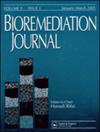Sustainable removal of Pb (II) from aqueous medium by using chitosan functionalized Citrus limetta peels biomass
IF 1.9
4区 环境科学与生态学
Q3 ENVIRONMENTAL SCIENCES
引用次数: 0
Abstract
AbstractIn this investigation, chitosan functionalized Citrus limetta peel biomass (ChCLP) was synthesized for adsorption of Pb (II). Results of energy dispersive X-ray (EDX) and X-ray photoelectron spectroscopic (XPS) confirmed the chitosan coating and adsorption of Pb (II). Functional groups like -NH2, C-H and -OH groups were present on the ChCLP surface. The surface of ChCLP was observed to be rough and porous. Langmuir isotherm was best fitted in the adsorption data. This indicated toward the monolayer adsorption of Pb (II) onto the homogeneous surface of the adsorbent. The suitability of pseudo-second order (PSO) kinetic model indicated chemisorption of Pb (II) onto ChCLP. Thermodynamic study revealed endothermic and spontaneous Pb (II) adsorption. Values of the diffusion coefficient and dimensionless numbers indicated that Pb (II) adsorption was mix diffusion and transfer controlled. It was found that both the experimental and predicted values for ChCLP was close to each other showing a high R2 value in the range of 0.94 − 0.98. Results showed that ChCLP has high Pb (II) removal capacity (99.8%) at 100 mg/L and 10 g/L ChCLP dosage. ChCLP adsorbent showed a high regeneration capacity in five consecutive adsorption-desorption cycles.Keywords: ANN modelingbiomasschitosan coatingCitrus lemetta peeldimensionless numberPb (II) AcknowledgmentsThe authors are thankful to the Institute for providing research facilities.Disclosure statementThe authors have declared no conflict of interests.壳聚糖功能化酸橙皮生物质可持续去除水中介质中的铅(II)
摘要合成壳聚糖功能化柑橘皮生物质(ChCLP)吸附Pb (II),通过x射线能谱分析(EDX)和x射线光电子能谱分析(XPS)证实壳聚糖包被Pb (II)并吸附Pb (II), ChCLP表面存在-NH2、C-H和-OH等官能团。观察到ChCLP表面粗糙且多孔。Langmuir等温线最适合于吸附数据。这表明铅(II)在吸附剂均匀表面上的单层吸附。准二级(PSO)动力学模型的适用性表明了铅(II)在ChCLP上的化学吸附。热力学研究揭示了吸热吸附和自发吸附Pb (II)。扩散系数和无因次数值表明,Pb (II)的吸附受混合扩散和转移控制。结果表明,ChCLP的实验值与预测值非常接近,R2值在0.94 ~ 0.98范围内较高。结果表明,ChCLP在100 mg/L和10 g/L投加量下对Pb (II)的去除率均达到99.8%。ChCLP吸附剂在连续5次吸附-脱附循环中表现出较高的再生能力。关键词:人工神经网络建模;生物质壳聚糖涂层;柑桔皮;无因次数pb (II)披露声明作者声明无利益冲突。
本文章由计算机程序翻译,如有差异,请以英文原文为准。
求助全文
约1分钟内获得全文
求助全文
来源期刊

Bioremediation Journal
ENVIRONMENTAL SCIENCES-
CiteScore
5.30
自引率
0.00%
发文量
36
审稿时长
9 months
期刊介绍:
Bioremediation Journal is a peer-reviewed quarterly that publishes current, original laboratory and field research in bioremediation, the use of biological and supporting physical treatments to treat contaminated soil and groundwater. The journal rapidly disseminates new information on emerging and maturing bioremediation technologies and integrates scientific research and engineering practices. The authors, editors, and readers are scientists, field engineers, site remediation managers, and regulatory experts from the academic, industrial, and government sectors worldwide.
High-quality, original articles make up the primary content. Other contributions are technical notes, short communications, and occasional invited review articles.
 求助内容:
求助内容: 应助结果提醒方式:
应助结果提醒方式:


